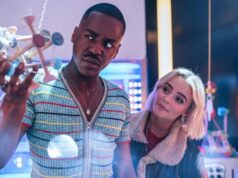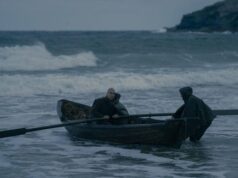
In August 1972, the Grateful Dead’s concert at the Old Renaissance Fairgrounds in Veneta, Oregon was recorded by a group of filmmakers, including Philip DeGuere, and released under the title Sunshine Daydream. DeGuere would later try to produce a film based on a fantasy novel published in 1983 by author George R.R. Martin prior to writing his books that became the basis for Game Of Thrones.
While DeGuere was unsuccessful in adapting The Armageddon Rag, he did manage to recruit musicians to create music for what would have been part of the film’s soundtrack. Among the characters in Martin’s novel was the fictitious 1960s band The Nazgûl. DeGuere tapped Grateful Dead lyricist Robert Hunter for the project and fellow longtime Jerry Garcia collaborator, keyboardist Merl Saunders. Others involved included Garcia and Saunders’ Reconstruction bandmate, drummer Gaylord Birch and Saunders’ son, bassist Tony Saunders.
In 1985, DeGuere was working in television, having created the popular weekly series, Simon & Simon. DeGuere, whose other notable TV credits include Black Sheep Squadron and JAG, was part of the team behind the reboot of The Twilight Zone series that ran from September 1985 to April 1989.
Though their previous work on The Armageddon Rag was scrapped, DeGuere once again enlisted Merl Saunders to help make the music for the new edition of The Twilight Zone. Saunders, who died at age 74 on this date in 2008, in turn enlisted Garcia and the other members of the Grateful Dead to write and record a new theme and music for use in episodes. Grateful Dead drummer Mickey Hart played an integral role in assisting Saunders, recording some parts from a hospital bed while recuperating from back surgery. Hart recalled the experience by writing:
“In the ’80s, The Twilight Zone was brought back to television in a new version. Merl Saunders was responsible for writing and completing the soundtrack and getting the Grateful Dead to perform on some of it. I was responsible for capturing sound effects and creating sounds for the score. We had a rock star team working on this. Executive producer Philip DeGuere was an amazing visionary, our acoustical consultant Betsy Cohen brought cutting-edge technology to the mix and synthesizer guru Bob Bralove helped tie it all together.”
Bob Bralove, who soon became a member of the Grateful Dead’s crew providing MIDI and other technical assistance and contributing auxiliary components during “Drums/Space,” talked about his experience working on The Twilight Zone, which originated when Saunders approached him at the 1985 Grammy Awards ceremony. Bralove was at the event as a member of Stevie Wonder’s crew. Wonder performed with fellow keyboard masters Thomas Dolby, Howard Jones and Herbie Hancock. On a recent episode of the Good ‘Ol Grateful Deadcast podcast, Bralove discussed working with Saunders and the Dead on The Twilight Zone:
“I was doing a Grammy show and Merl was very involved with NARAS, the Grammy organization. I was doing a Grammy show in LA, this big synth thing with Thomas Dolby, Howard Jones, Stevie Wonder, and Herbie Hancock. All had #1 hits that year with heavy synth stuff. Merl comes up to me afterwards, looks at me, looks at the stage, and says, ‘You know how to operate those things?’ I say, ‘Yeah, I do that for Stevie.’ And he goes, ‘You ever want to do television music?’ And he invited me to work with him on The Twilight Zone, which was the CBS remake of The Twilight Zone in the ‘80s. Merl had the contract and he was bringing in the Grateful Dead as part of that.
“The first thing I started doing with the band was recording them in a room. I remember we had this really strange isolation room in Front Street. Just a tiny room — tiny for the size of the warehouse, but totally padded and totally isolated. I don’t know if you’re aware, but Front Street was not a sound isolation kind of environment. It was just a big warehouse that they set up structures, depending on what was going on. The control room was not isolated. This was the room, and I had Bobby in there. I had this list of ideas that he should play. I would record them and the idea was to use them in the show, even when they were away or if they didn’t feel like coming in. They were things like: ‘Alright, play first view of the coffin, or you realize he’s still alive.’ And Bobby would go — first you do the coffin and Bobby would do his quintessential [mimics guitar sliding sound], and you just placed that in the right place. It was magical.
“Mickey got very involved in sound design. We would record on tracks and send them to LA. Mickey and Merl were having territorial issues over the soundtrack, and I was working with both of them. They would fight over my time. It was really kind of funny because I was the only one going to both sessions. So it was a wonderful introduction to Mickey because those kinds of sonic worlds that he lived in — totally Twilight Zone. For me, there’s that aspect of 1950s, 1960s and, through the 70s, of that sort of classical avant-garde that was very idiosyncratic to instruments. It was a tradition to use an instrument in the only way that instruments spoke, in the John Cage way. George Crumb, all those guys were pushing the envelopes of these things. And so here was Mickey, using waterphones and Tibetan prayer bells and pitch-bending them. So I just dove right in — we saw eye to eye right away on that stuff. And so we made a good connection.”
The 1985 Twilight Zone theme incorporated elements of the theme composed by Marius Constant for the second season of the original 1959 Rod Serling-created series. Along with opening and closing credits music, the soundtrack also showcased recordings made by Saunders and the Dead for use in episodes, with titles such as “The Twilight Zone ’85 Main “Nightcrawlers: Suite,” “I Of Newton,” “Children’s Zoo,” “Can She Type?,” “The Shadow Man: Suite,” “The Misfortune Cookie: Suite” and the three-part “Kentucky Rye.”
Stream the Grateful Dead and Merl Saunders’ Twilight Zone soundtrack by clicking through the playlist below:
On March 9, 1985, Merl Saunders made his third and final appearance onstage with the Grateful Dead during their concert at Berkeley Community Theater in Berkeley, California. Saunders emerged for the “Drums” and “Space” jam section of the second set, during which the new Twilight Zone theme prominently appeared. Saunders remained seated next to keyboardist Brent Mydland for the subsequent “The Other One” that rumbled out of the improvisational sequence.
Stream Merl’s final time playing with the Grateful Dead — listen for The Twilight Zone theme — below:








